How Consultants Can Get Clients with Newsletters: 10 Steps
My personal lessons on how to use a consulting newsletter to build trust, stay top of mind, and turn leads into a steady flow of paying clients.

Most clients don't hire consultants after the first call.
They come back months, sometimes years, later, when the timing finally clicks.
The problem? By then, most consultants have faded into the background. Out of sight, out of mind.
In B2B marketing, this is often called the "95-5" rule - the idea is that only a single-digit fraction of your target market is ready to buy right now.
This is why a newsletter is one of the top 3 highest ROI channels in 2025 that B2B marketers use. It keeps your voice in their inbox week after week, building trust long before customers are ready to sign.
Most executives making buying decisions are in their inbox way more than on platforms like LinkedIn. And you're much more likely to hit the inbox than you are the top of someone's LinkedIn feed. When done right, it bridges the gap between "great chat" and "let's get started."
Email marketing provides a 261% ROI, with a break-even point of 7 months and a 3.5 ROAS. B2B email campaigns average a 2.4% conversion rate, slightly trailing B2C campaigns at 2.8% . - Hubspot
The beauty is, you don't need to fight social algorithms or post every day.
Odds are, much of your list will already know you. Maybe they've met you, heard you speak, or were referred by another client, so they'll already be more likely to open your newsletter. And you're an expert in your field, so you have a ton of unique, interesting insight for them.
That's what separates forgettable consultants from the ones that stand out in prospects' minds. And that's what we help build at Potions: newsletters that stay consistent, sound like you, and nurture every lead in your CRM until they're ready to hire you.
Unlike most newsletters that are treated as just an educational marketing touchpoint, the newsletters we launch for consultancies are built into their GTM operations, often bringing in 5 leads every week.
The 10 steps below are my secret sauce for running successful consultant newsletters like CIOsurge, AUDEO, Content Detox, and many more.
This guide is super in-depth (I made it as actionable as possible), so feel free to skip ahead depending on how advanced your newsletter marketing knowledge is:
- Step 1. Get Your Newsletter Plan Together
- Step 2. Choose the Right Newsletter Service
- Step 3: Plan Your Content Layout
- Step 4: Design Your Template
- Step 5: Nail Down Your Brand's Voice & Tone
- Step 6: Create Email Workflows To Support Your Newsletter
- Step 7: Build & Grow a High-Value List
- Step 8: Create a Content Strategy Where You're the Expert
- Step 9: Stay Consistent & Optimize
- Step 10: Turn Engagement Into Clients
- Or…You Could Let Potions Handle Your Newsletter For You (& skip most of those steps)
Step 1. Create a Plan for Your Consulting Newsletter
Before you start writing, get clear on who you're speaking to and why. This step shapes everything — your topics, tone, and what turns readers into future clients.
Use these 5 questions as a guide:
Question 1: Who's your "audience of one"?
Start by picturing your ideal client, the type of person who benefits most from your services. When you imagine your newsletter in their hands, who are they? What kind of business do they run? What keeps them up at night?
Alex Lieberman, the founder of Morning Brew (probably the most successful newsletter ever), calls this your market of one.
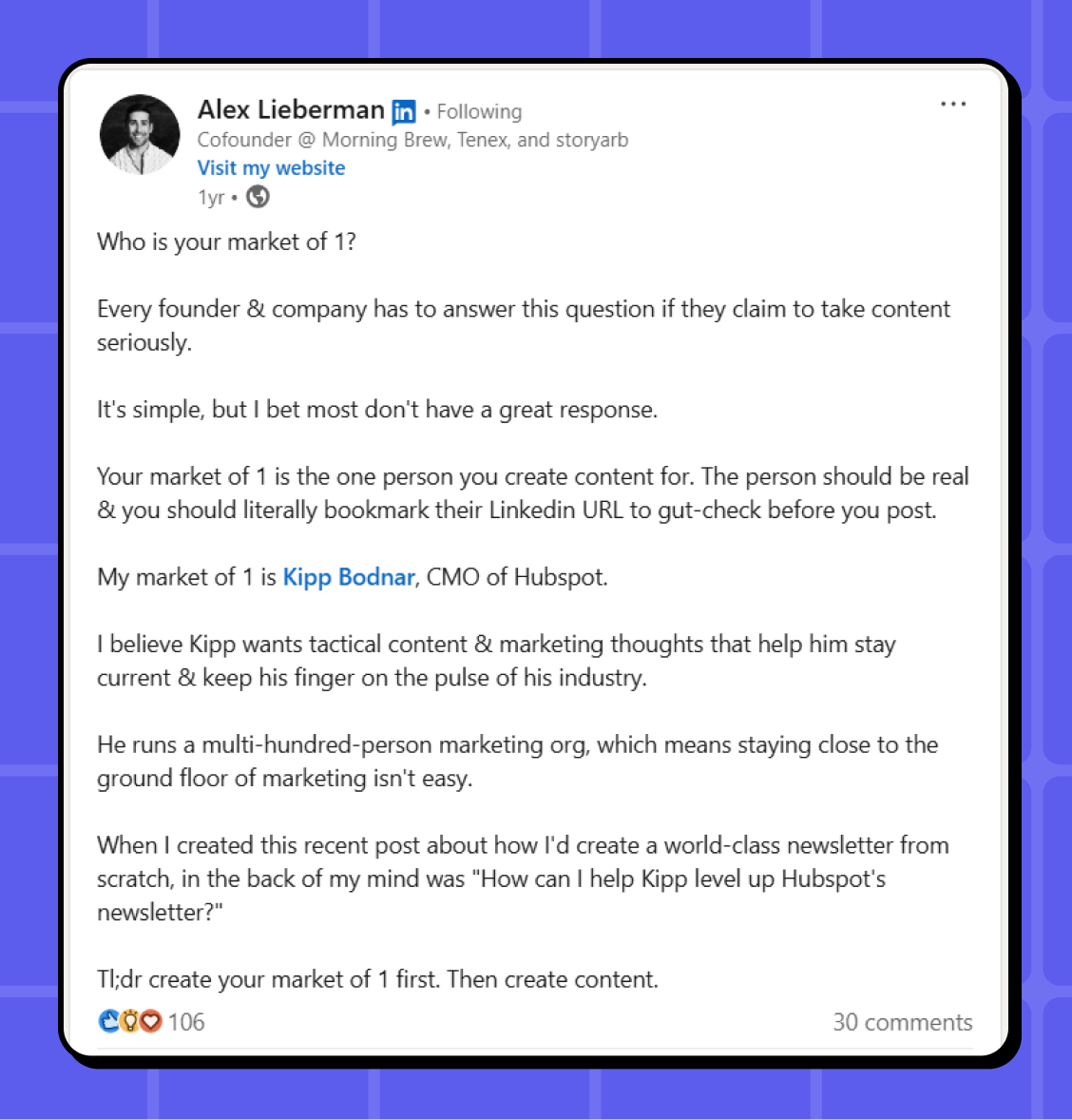
You probably already know this person because they're a version of your best clients. That's your audience. Actually, forget the audience, and just picture that one person.
Here's the trick: write as if you're speaking to that one person. Imagine sitting across from your ideal client. When you write to them, your message becomes sharper, more relatable, and way more genuine.
Make that one reader feel understood, supported, and solve their problems. If you do that, your entire audience will feel it too.
Question 2: What problems will your newsletter solve for your audience?
Start by thinking about what problems your readers are trying to solve. Your newsletter should make them feel informed, supported, and one step closer to solving the pain points they face on the daily.
Every consulting niche has its own version of this…
- Financial consultants 👉 clients procrastinate financial planning
- IT consultants 👉 clients face costly cybersecurity threats
- Legal consultants 👉 clients constantly risk non-compliance due to rapidly evolving regulations
Each newsletter should help readers make better decisions and remind them you're the consultancy who can help.
Question 3: How will you make it unique?
Let's be real: Our inboxes are flooded with emails we never read, and there's no shortage of newsletters. Substack alone has 75k+ newsletters (and that's just one platform).
Before I launch a new newsletter, I look at what similar newsletters currently exist, and I note:
- Why I think those newsletters are successful
- What I think could be improved
- What they're missing
This will help guide your newsletter's unique positioning in the market, just like you'd approach launching any product. Yes, you should think of your newsletter as a product.
Your perspective and in-the-trenches insights make your newsletter unique. So, share your frameworks, lessons from client projects, turn the topics that regularly come up on client calls into content, and put your own spin on industry news to shape your audience's perspective.
Your newsletter is a product. It needs to solve a problem, and be differentiated.
Present problems you know you can solve in an exaggerated way to grab your reader's attention and flex your expertise. A great example is Farmer's Insurance ads. They turned their most outrageous claims into commercials with the slogan, "We know a thing or two, because we've seen a thing or two." They're showing proof of their expertise with unforgettable wild claims.
You could even feature some of your clients in a Q&A section to address topics you run into regularly, if that would interest your audience. Spotlighting your current clients is another cool way to use your newsletter.
Question 4: What content does your audience like?
Not sure what content your audience likes most? Look at what's already working.
Internally, review your LinkedIn posts, client presentations, or Q&As that get people talking. Repurpose those ideas into short, focused newsletter segments.
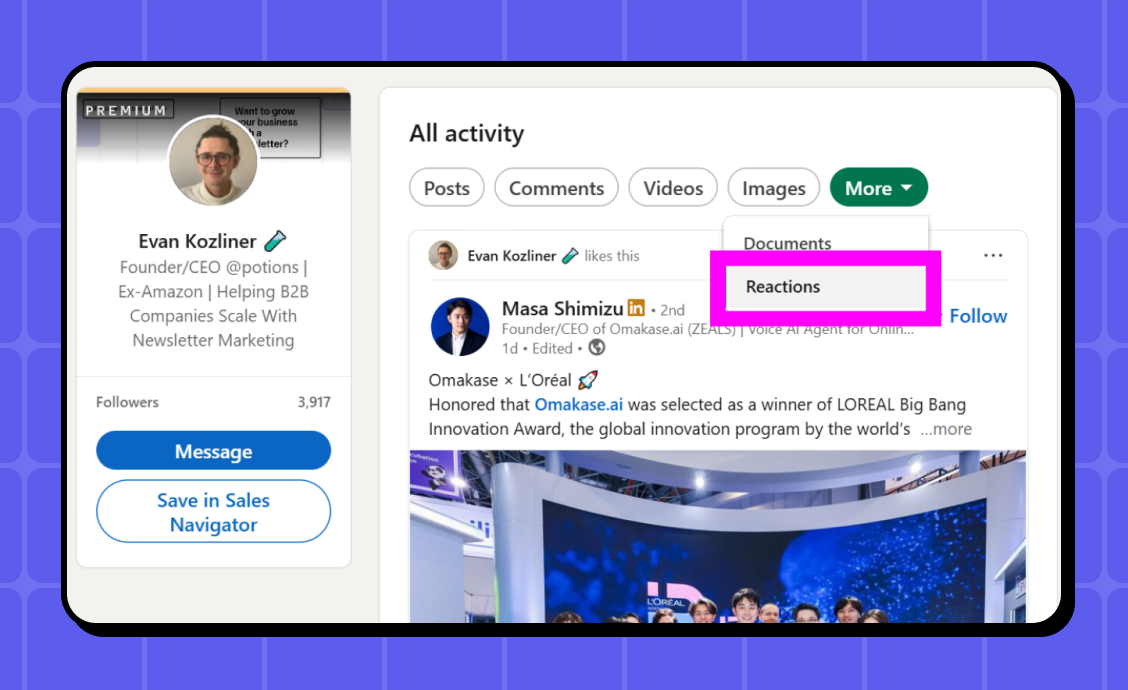
Externally, study content from other industry influencers that your market of one loves. You can literally visit your dream client's LinkedIn (or other social account) to see what posts they Like or engage with.
Then, note what topics, themes, and styles resonate most with them. Lean into those patterns.
Question 5: How often will the newsletter go out?
For most consultants, weekly or bi-weekly is the sweet spot. But frequency is pretty industry-specific. If you're in a fast-paced industry with rapid change, like tech, weekly is probably the minimum, but in a slower-moving field, like accounting, you could send less often.
What matters more than frequency is consistency. Whether you send weekly, biweekly, or monthly, stick to a schedule you can maintain.
Once your audience expects to hear from you, your newsletter will become a part of their regular routine.
Step 2. Choose the Right Newsletter Service
There are literally dozens (if not hundreds) of newsletter platforms on the market, each with its own unique features, integrations, support, and pricing structure.
The platform you choose needs to grow with you, support your unique needs, and be easy to use. Don't let choosing the wrong platform be the reason you give up on running your newsletter.
What kind of platform do you need?
Start by being honest about how hands-on you want to be. If you have the time and enjoy writing, traditional newsletter platforms like Mailchimp make it easy to design, schedule, and send your newsletter on your own.
Beware: Don't make the mistake of choosing one of the most popular options, like beehiiv or Substack, just because you see a lot of other newsletter operators using them. The problem with platforms like these is that they're designed for creators — not for businesses with high-value lead lists — so you'll be left out to dry when it comes to integrating with your current tech stack or even support (they typically prioritize users with big lists).
On the other hand, if you know you need a newsletter, but can't be bothered to learn every nitty-gritty technical detail of running one, a done-for-you service like Potions gives you both: the platform AND the team to run your newsletter almost ENTIRELY for you, at a steal of a deal.
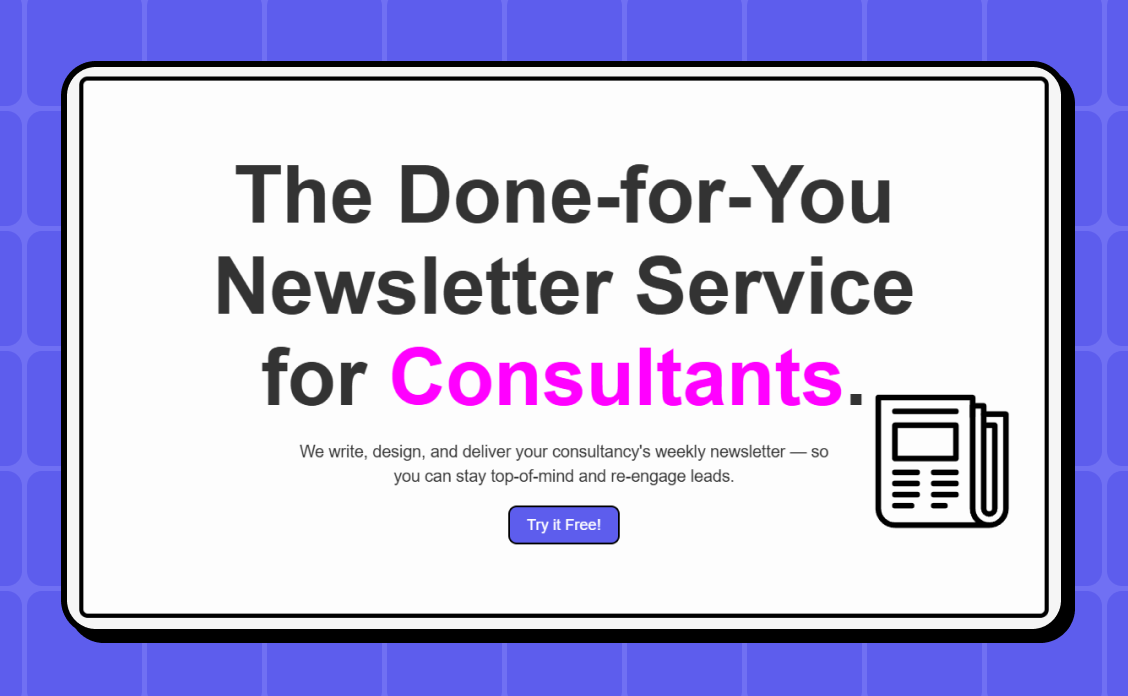
Potions handles your newsletter end-to-end — content, design, list cleaning, sending, and growing subscribers — so you can stay dialed in on client work.
Each newsletter positions you as a thought leader in your space, and we'll let you know who's reading and clicking so you can follow up and strike (reach out) while the iron's (lead's) hot.
What features matter most?
Don't get distracted by flashy dashboards or extra tools you'll never use (cough cough Hubspot). The best newsletter platform is the one that makes sending simple, reliable, and seamlessly integrates into your business.
At the bare minimum, your platform should make it easy to:
- Keep your email list clean by filtering out undeliverable or inactive subscribers
- Customize your newsletter template
- See analytics down to individual subscribers
- Connect to your workflows and tech stack
- Scale as your list size grows without drastic price jumps
- Provide accessible and knowledgeable support for when you run into technical issues (a lot of platforms have subpar support for users with small lists)
Step 3: Plan Your Content Layout
When we launch a new newsletter, we help our clients choose the type of content they want to include and plan the layout that every issue will follow. This usually includes several repeatable sections for different types of content.
Your consulting newsletter should be made up of content sections that your market-of-one cares about and will find interesting. This could include:
- Stories
- Tips (e.g., at the end of your take on a news story, give your readers an actionable takeaway they can use)
- Case studies
- Lessons learned
- Industry news with your personal take
- Tools or other resources worth sharing
- Memes (everybody loves a good meme)
Mix it up to give readers value and variety. Remember, you want your content to be interesting, you don't want to regurgitate the same information every other consultant in your industry talks about all the time. And if it is a hot topic everyone's talking about, think of ways to make your presentation original.
Your readers should know what to expect from you each email. The easiest way to do that is by having a couple of repeated sections.
We often recommend between 2 - 4 sections, but lots of newsletters do well with a simple single idea drip.
Step 4: Design Your Newsletter Template
Once you've decided on your content sections and where they'll appear in your newsletter layout, it's time to design your template.
Design can be the difference between "okay" marketing and GREAT marketing.
Design makes your newsletter stand out and helps it become recognizable as yours. But it's worth noting that some email clients can't handle heavy design in emails. For example, in Outlook, background images don't load. So, you need to check where your market of one is receiving emails before you choose your design elements.
With Gmail, you can be more creative, but if your newsletter is going to Outlook inboxes, you'll need to be more conservative to make sure it looks like it's supposed to. If you'll be sending to Outlook inboxes This article goes more in-depth on this.
Some basic design rules to follow:
- Keep your design elements simple and easy to read on all devices and screen sizes.
- Pick colors that match your brand and won't make the content harder to read (especially for the visually impaired).
- Stick to one or two fonts that are supported by most devices and apps.
- Stay away from extremely generic design
- Don't ignore highly simple design either! A newsletter that "looks" like a personal email can often be best.
Most of our customers use banners at the top of their newsletter template for a more branded feel.
A banner should be simple, maybe your newsletter title with a quick value prop or slogan. Try to keep it slim in height, so people don't have to scroll much to reach the content. For desktop users, 650-700 pixels wide and 90-200 pixels tall works well. For mobile users, the best banner is 350 pixels wide and up to 100 pixels tall.
You can also use dividers to break up sections and make it more skimmable.
For our customers who don't have access to designers, we have our designers create on-brand design elements, which is a pretty unique feature our clients love.
Always keep your file sizes lean for banners, dividers, or other images. Compress your images with a tool like Kraken and limit their width to 600px, since that's pretty much the limit in email.
Some people go overboard with huge images that take forever to load. If you use Potions, don't worry, we'll always catch that.
Note: Emails over 102KB are more likely to be filtered as spam or cut off in the middle, forcing readers to click again to read the full version (if they figure that out). This limit includes everything in your email: Words, images, links, HTML tables & dividers, Inline styles & CSS, tracking code, and hidden preview text. As a rule of thumb, aim for roughly 1,200 or less words per issue so it's long enough to be valuable but short enough to not exceed the email file size limit, especially if you add image files (each character in a plain text email typically takes up 1 byte of data).
Step 5: Nail Down Your Brand's Voice and Tone
Before you write, imagine your market of one. The best newsletters read like a conversation with one person. When your writing sounds human and familiar, readers start seeing you as someone they know and trust faster.
Voice and tone
Your voice is your personality. It's how you sound in everything you create, and it doesn't change. To find it, reread messages you've sent to clients. Notice your phrasing, humor, and pacing.
Notice how your clients speak too, and mirror their language where it makes sense.
When you draft your newsletter, read it out loud. If it sounds like something you'd actually say to that client across the table, you're there.
Your tone, on the other hand, can shift depending on what you're writing about. A strategy consultant might sound direct and analytical, while a creative consultant might be more playful or curious.
Most of our consulting clients use a confident, insightful tone that's conversational. Some might go with a more authoritative tone, like CIOsurge (geared toward technology leaders).

Another Potions customer, Anthony Miller's newsletter AUDEO, sounds like it was written directly to his audience, with a confident, conversational tone.
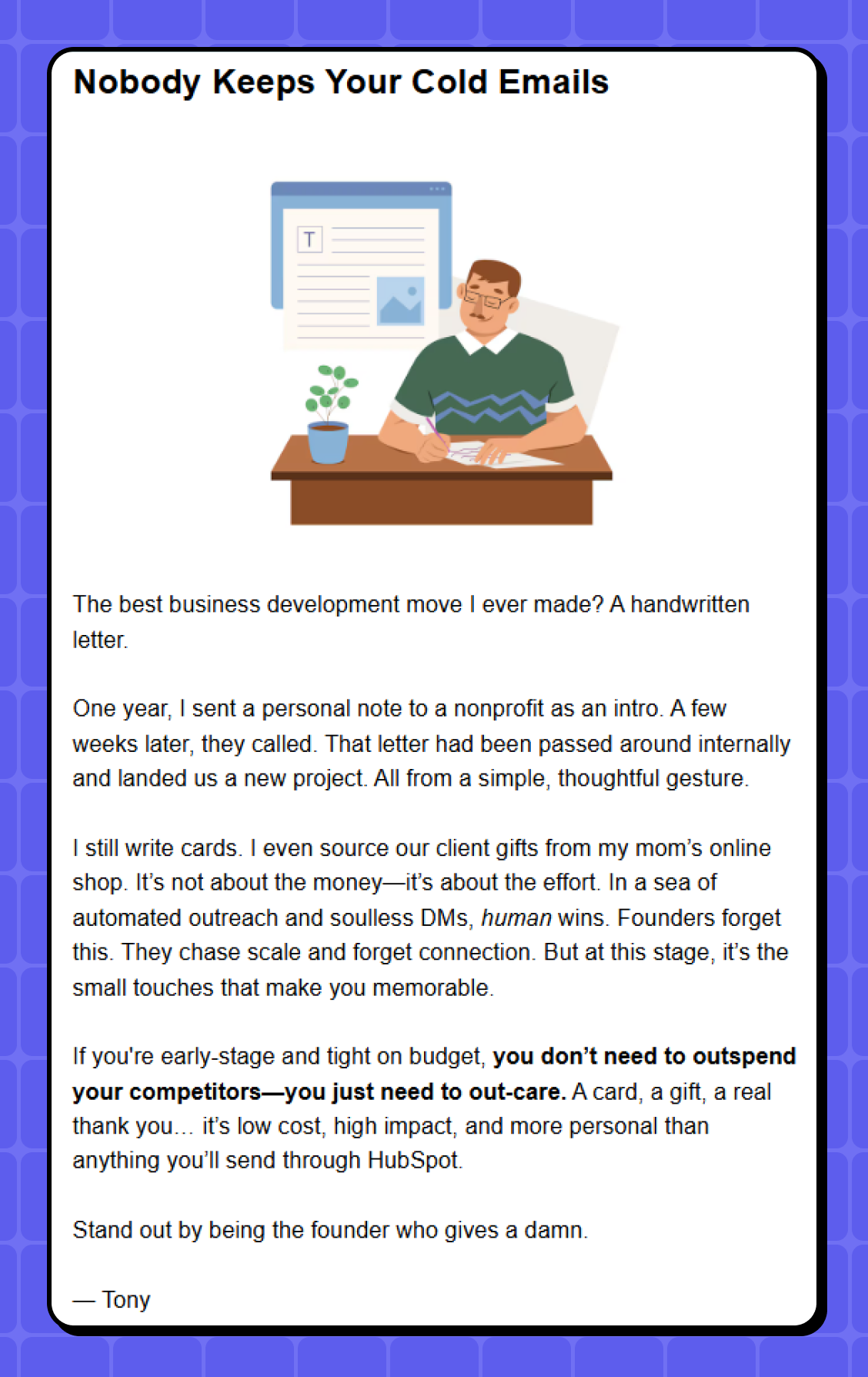
Step 6: Set Up Email Workflows To Support Your Newsletter
Your newsletter shouldn't live like a solitary floating head in cyberspace. A few simple workflows can help you welcome new readers, re-engage quiet ones, and keep your audience warm.
Launch Email: Announcement to existing contacts
The highest-performing e-commerce email is the abandoned cart, with a 44.1% open rate and 29.9% of those resulting in a recovered sale. Newsletters are the "abandoned cart" email for consultants, but for some reason, most don't send them.
When your discovery calls don't result in a new client, you can use your newsletter as a way to follow up.
And before chasing down new subscribers, send a quick announcement to the people already in your world. Let them know you're launching a newsletter and invite them to join. Keep it short and conversational, something like:
"I'll be sharing short insights every Thursday that help you [insert benefit]. Want in?"
It reframes your newsletter as a free resource instead of a pitch they feel forced to subscribe to.
Newsletters are the "abandoned cart" email for consultants, but for some reason, most don't send them.
Welcome email
When someone new signs up, they should immediately get a friendly note explaining what to expect and when.
Your welcome email should reintroduce who you help, what kind of insights they'll receive, and link to one or two of your best posts.
End it with a CTA to check out a free resource, book a strategy session, or reply to the email with a question or thought. This kills two birds with one stone: 1) It acts as a potential sales touch point if a lead is in-market to buy, and 2) It increases the likelihood future emails will land in the main inbox if they engage.
B2B Saas Reviews' welcome email is a great example.
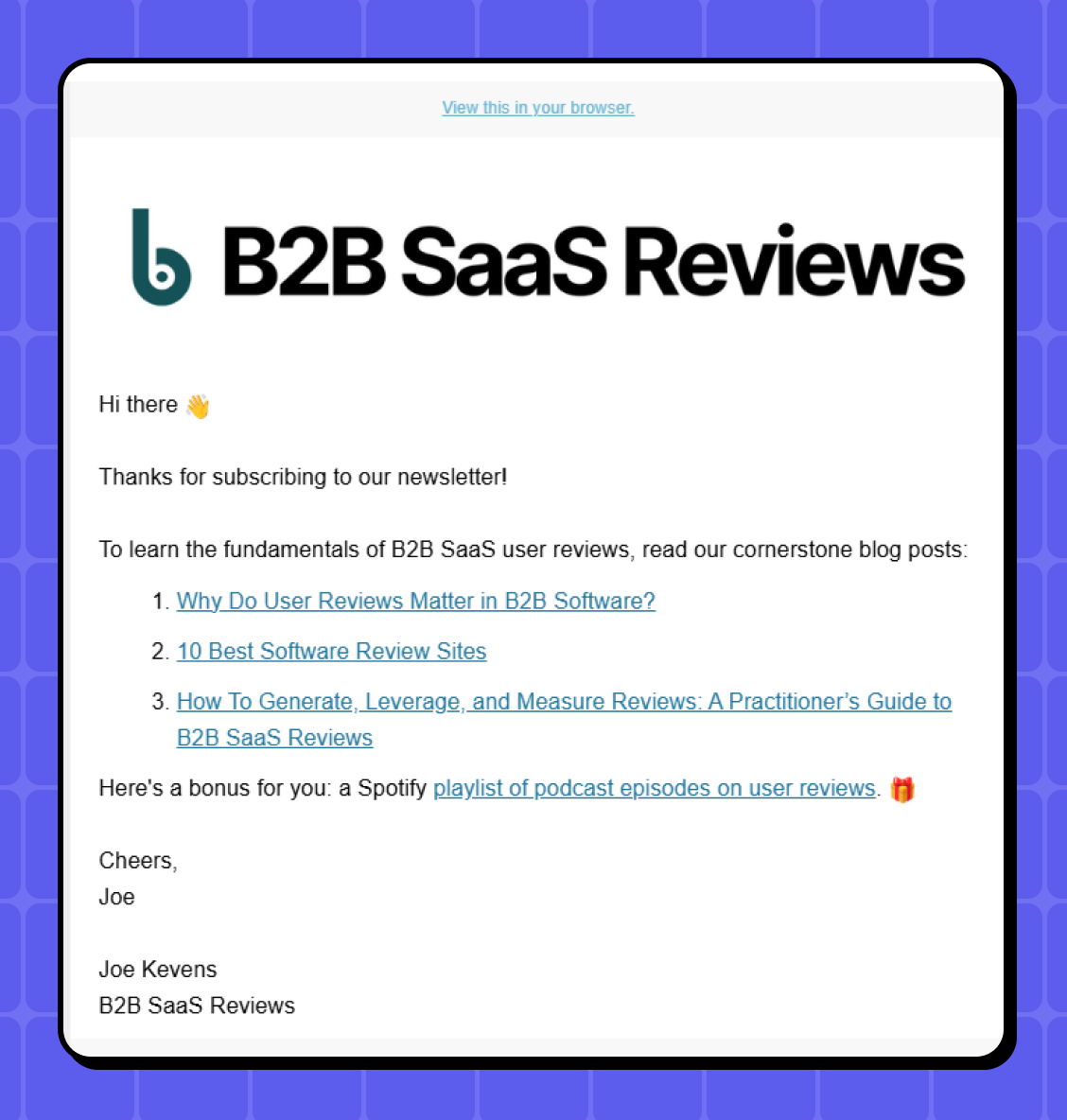
You don't need a long drip sequence here. One well-written welcome email is enough to build context and trust. However, if you have evergreen content, it can be worth doing a drip sequence before introducing people to your newsletter to build credibility. For example, I know a cold email consultant who has amazing drip sequences for cold emailing. They're really high-value content, and they're evergreen, so he doesn't really have to change them.
Re-engage or remove email
Plan for list hygiene. If someone hasn't opened your newsletter in a while, send a polite check-in asking if they still want to stay on the list. If they don't respond, remove them. This will improve your overall engagement rates and decrease your chance of being flagged as spam by email providers.
You're goal is to get replies with this email.
Sometimes open and click data isn't accurate because some email providers block tracking. This can cause you to need to send a breakup email, even if the subscriber has in fact been reading (you can't tell if they were!).
See how Stu McLaren's email asks for a reply in order to keep getting his emails.
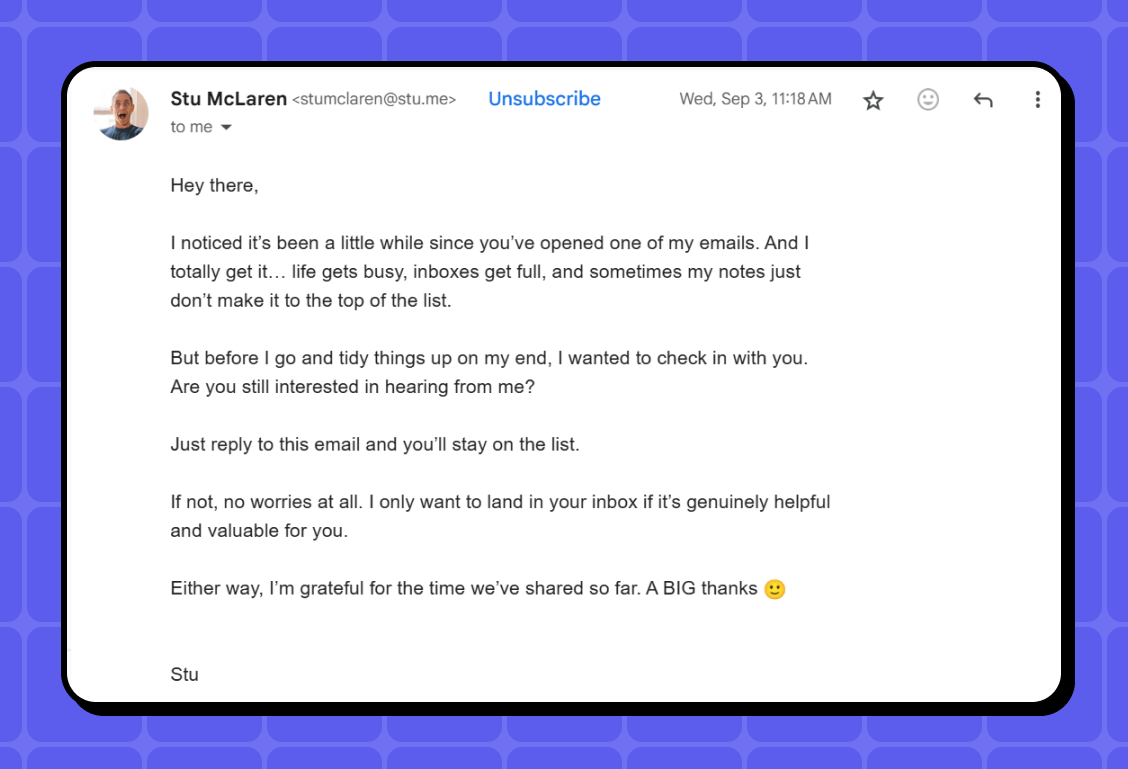
Step 7: Build & Grow a High-Value Newsletter Subscriber List
A valuable newsletter list is built on relevance over quantity. Small, engaged lists outperform a massive, unengaged one every time.
Some of the best-performing newsletters I've seen started with fewer than 100 people because they were engaged and hyper-relevant.
The smaller the list, the easier it is to build relationships, and as a consultant, you know relationships are what converts clients.
Drip your marketing, sales, and outbound leads into your newsletter list
The easiest way to jumpstart your newsletter with a high-value list is to import the leads you already have. These could be old marketing leads in your CRM who downloaded lead magnets, or old sales leads you want to stay top-of-mind with. Just be sure you use an email verification tool to remove old emails that won't deliver (B2B lists tend to decay 3.6% every month).
That stat alone is another reason to start your consulting newsletter. Sending a newsletter consistently protects your list. If you haven't emailed a contact in 12 months, it's really back to being a cold email. A newsletter keeps your email list warm.
After a new lead books a discovery call, build a simple automation that adds contacts from your Calendly, Zapier, CRM, or outbound sequences straight into your newsletter list (with consent, of course).
If you don't use an ESP integration with Calendly, you can edit the content of your email confirmations or follow-up emails via Calendly's "Workflows" feature to include a CTA and a link to your newsletter signup page.

You can also make it part of your outreach by including a CTA at the end of your messages, something like, "Would you like to get insights like this in our newsletter?" (with a link).
Once you've done this, move on to intentional list-building.
B2B lists tend to decay 3.6% every month. And, if you haven't seen to a contact for over 12 months, they become effectively "cold", making it harder to reach them in the future.
The true value of a newsletter is the sum of the sales pipeline you kept warm.
Create lead magnets that attract subscribers you'd want for consulting clients
The best way to grow your list is to offer something worth trading an email for. Think small, specific, and useful lead magnet ideas — something that solves a real problem your ideal clients face.
When they access it, you want them thinking, "If this is what they give away for free, imagine what working with them is like."
Depending on your industry and offerings, you could create:
- Ebooks – Offer a focused, high-value resource that answers a recurring client question. This financial planning firm offers a free ebook in exchange for your email.
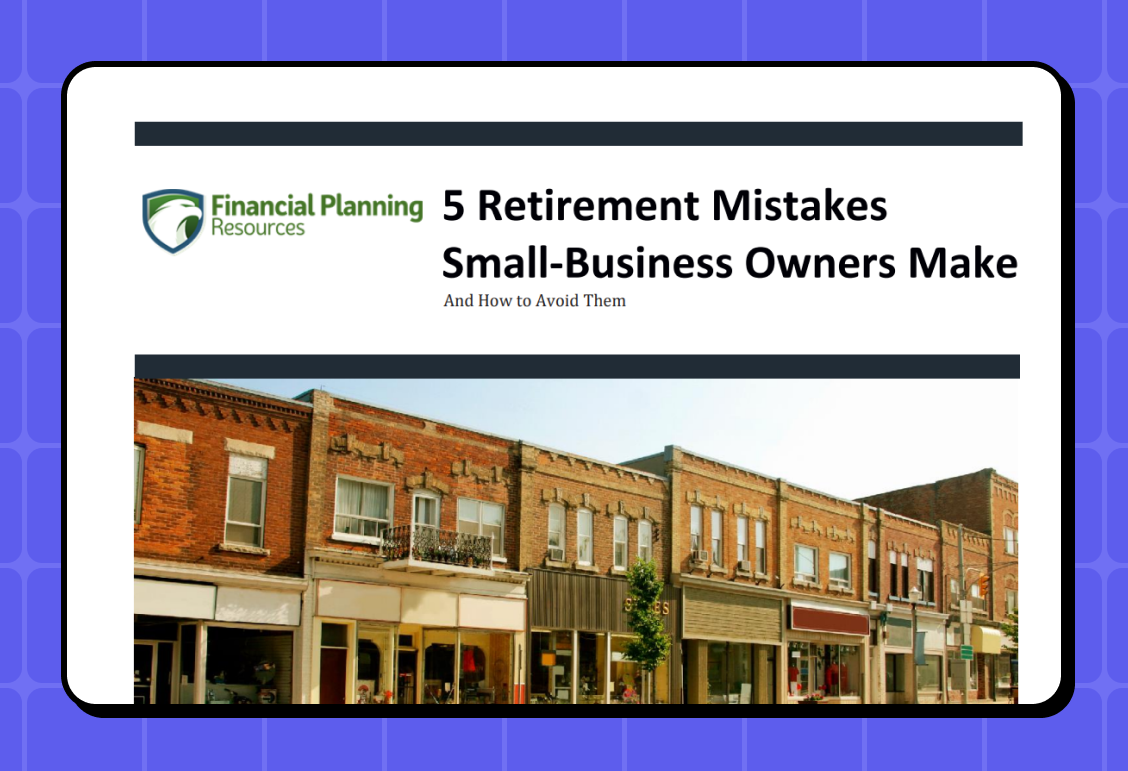
Free trainings – Host a short, actionable session that highlights your expertise. This estate planning law firm uses free webinars to build its email list.
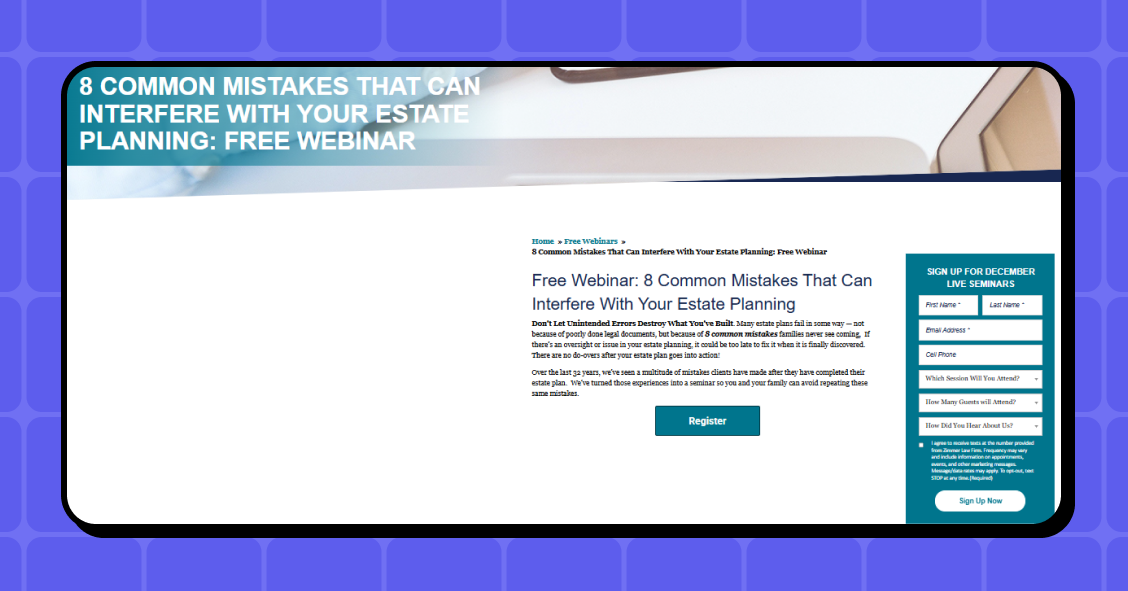
Industry reports – Summarize data to help your clients and add your analysis. For example, Jason Staats helps accounting firms become more profitable. He created this free report comparing 14 different practice management platforms.
Free tools – Build simple calculators, templates, or AI-powered workflows that make your audience's job easier. This consulting firm helps independent consultants make more money and offers a free consulting rate calculator in exchange for subscribing to their newsletter.
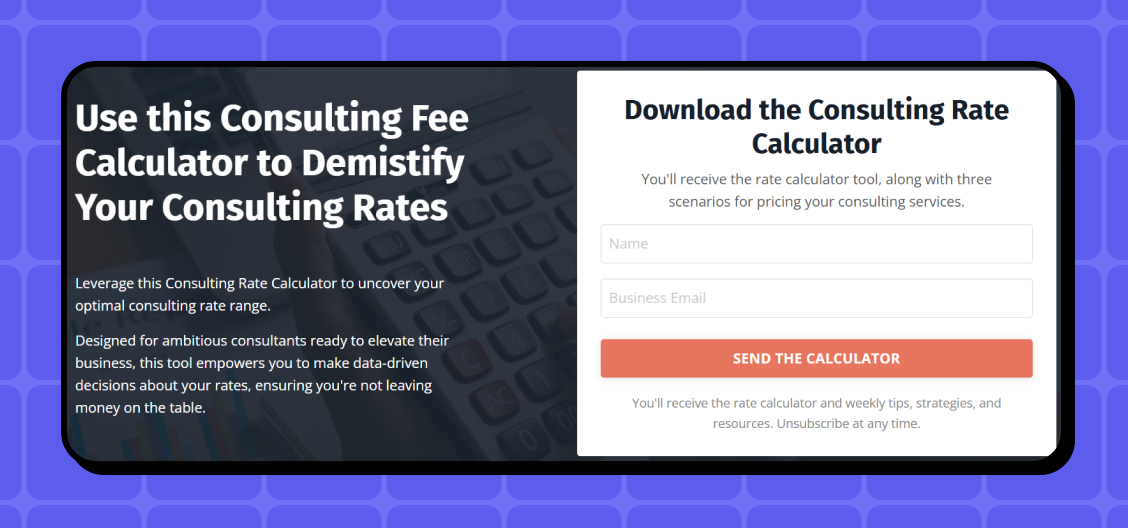
Workflows or checklists – Turn your internal processes into plug-and-play assets. This marketing consulting firm offers a list of marketing audit questions it uses in its own workflows.
Dynamic quizzes – Use a short quiz to help readers diagnose pain points. Perspective or Typeform is an excellent platform for quizzes. This leadership development consulting firm offers a free quiz to identify your leadership style.

Free strategy sessions – Offer a short consultation to start real conversations with qualified leads. Para Consulting, a business systems consulting firm, offers a free system audit.

Meet your audience where they are
Promote your resources in the spaces your clients hang out. For most consultants, this will be LinkedIn. Add your newsletter and lead magnet CTAs to your top-performing posts. Add opt-ins to your blog, YouTube videos, or presentations. If you speak at events, make your newsletter the natural "next step" CTA.
You can also cross-promote with other consultants or creators in your space. This could be with another influencer who has a newsletter with a similar audience, OR you could collaborate on a piece of content with them to promote in your newsletter (with the goal that they share it with their audience too).
And if the numbers make sense, test paid campaigns to accelerate growth. Don't be fooled by the $1-$2 cost per subscriber folks get on consumer newsletters; you're going to pay a lot more for readers that are decision makers (often in the 10s of dollars per acquisition, depending on your market).
If you don't want to deal with learning ads, you can use a service like Potions to help set up ads and bring in subscribers who fit your client profile.
Be mindful about growth
Try to add contacts who've had a positive interaction with your brand (like a discovery call or lead magnet) as long as you give them a clear, easy way to opt out and respect any prior unsubscribes. This will help protect you from fines from the CAN-SPAM Act.
If you're new to email marketing: Deliverability refers to the ability of your emails to land in your recipient's primary inbox (not the spam or promotions folder). The lower the engagement that your emails get, the less likely you'll land in the right inbox in the future.
So, start small when sending your newsletter, especially when you haven't sent that many mass emails before. Gradually add contacts (if you're importing a list), and focus on engagement.
A clean, permission-based list will protect your sender reputation and make sure your newsletters land in the inbox, not spam.
Start small when sending your newsletter, especially when you haven't sent that many mass emails before.
Step 8: Create a Content Strategy That Proves Your Expertise
Your newsletter is both a touchpoint and proof that you know your stuff. Each issue should remind readers why you're the trusted choice in your field by sharing insights they can actually use.
Start with client pain points
Think about what your clients struggle with every day. What questions come up on repeat? What blind spots do you see again and again? That's your content gold. Use it to show you understand their world better than anyone else.
For Content Detox, our customer Jacob Statler's newsletter for B2B content marketers, he focuses on stories around evolving algorithms and actionable tactics to get more customers from content.
Keep it practical. Share short frameworks, lessons from client projects, or quick wins your readers can apply right away. Bite-sized insights are easy to digest, and they reinforce your authority with each issue.
Mix original and curated content
You don't have to create new content from scratch every week. Repurpose what you already have:
- LinkedIn posts could be quick tips
- Blog posts can be deep dives (but keep in mind, most long-form SEO blog posts are too long for inboxes, so you'll need to summarize and adapt)
- Case studies and client calls could be short stories
- A podcast or video could be summed up with the top takeaways
Don't currently have content? You can easily curate content from around your industry, but make it your own. Share relevant industry news or trends, and layer in your perspective. Think of it as curation with context. You're filtering what matters and explaining why it matters.
In addition to curating top industry news stories, we like to make it as effortless as possible for our busy consultant customers with four ways to make original newsletter content:
- Chat with our AI and we'll create content based on the transcript
- Add a voice note talking about your content idea
- Add a URL of content you want to use with your personal context
- Upload text or documents to be repurposed
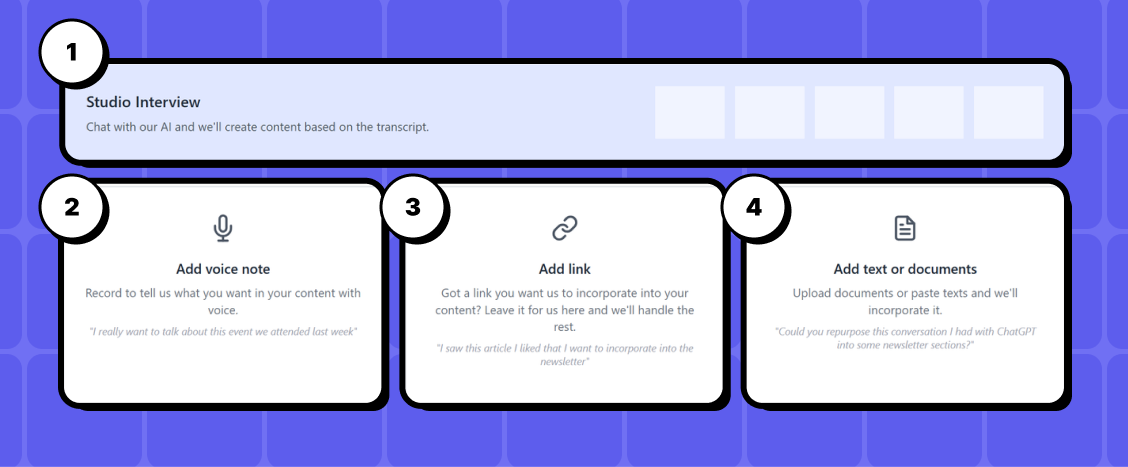
Then, our AI and writing team turns those insights into an actionable story that sounds exactly like them.

Feature others to build connection
Don't make your newsletter a one-way street. Feature a client quote, a partner's insight, or a quick Q&A with another expert. It keeps your content fresh and organically grows your network.
Including features of others in your industry also acts as a content-based networking play. It helps you get your foot in the door with leads or referral partners.
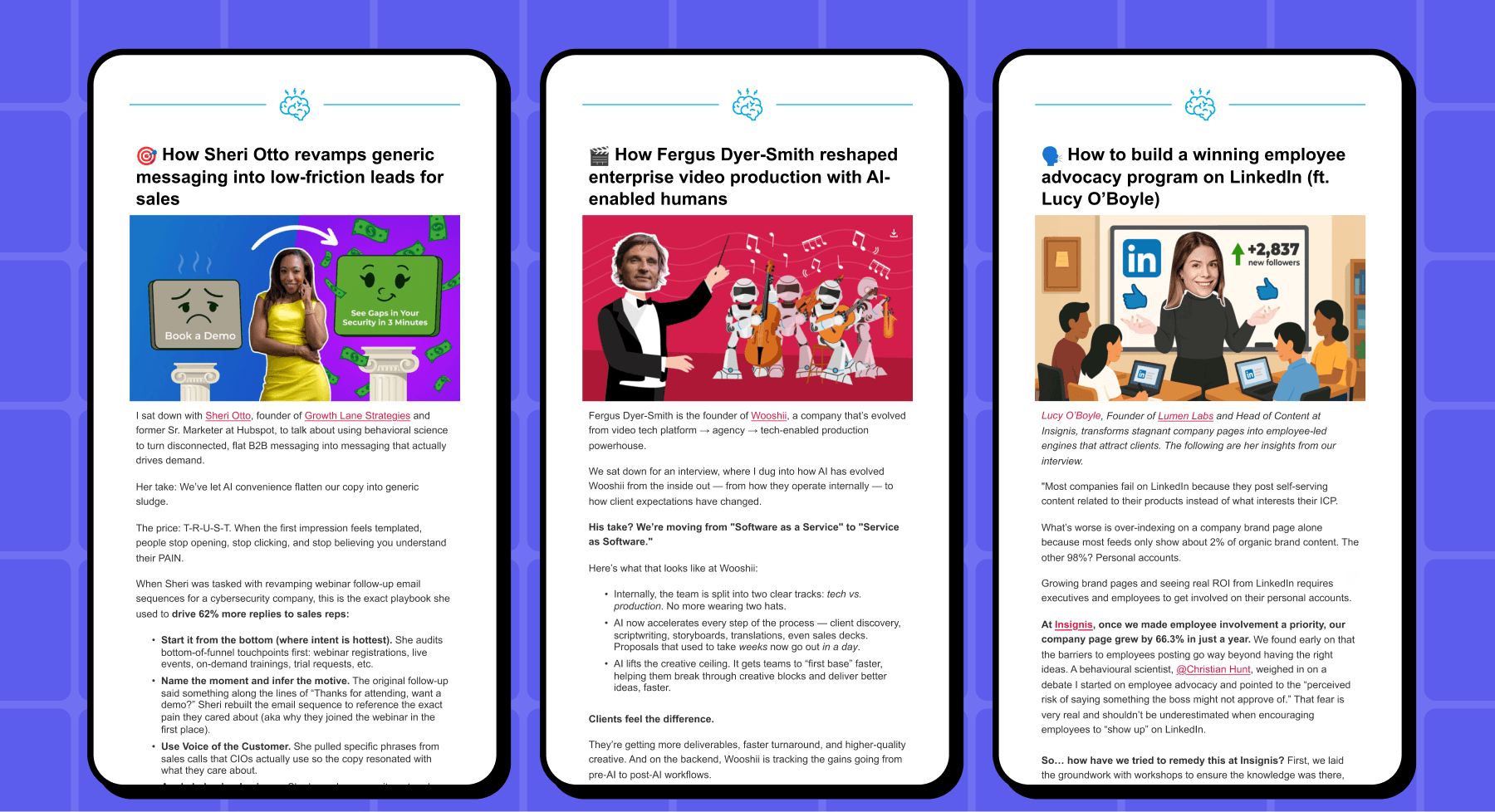
Although featuring them in a story shouldn't be an invite to pitch your services, it's a great way to start a relationship by providing value.
End with a natural next step
Close each issue with a clear, conversational CTA. Invite readers to book a call, reply with a question, or check out a resource. It should feel like continuing the conversation, not a pitch.
Try to avoid phrases like "free" or "for a limited time", especially in the beginning of your newsletter journey. As your domain earns more trust with the ISPs (e.g. Gmail) you can sprinkle that stuff in. But you don't want to come out of the gate getting classified as a cold emailer.
I like how our client newsletter, The Augmented Leader, ends with 2 CTAs: the first is an option to get started, the second provides more information for those not quite ready to jump in.
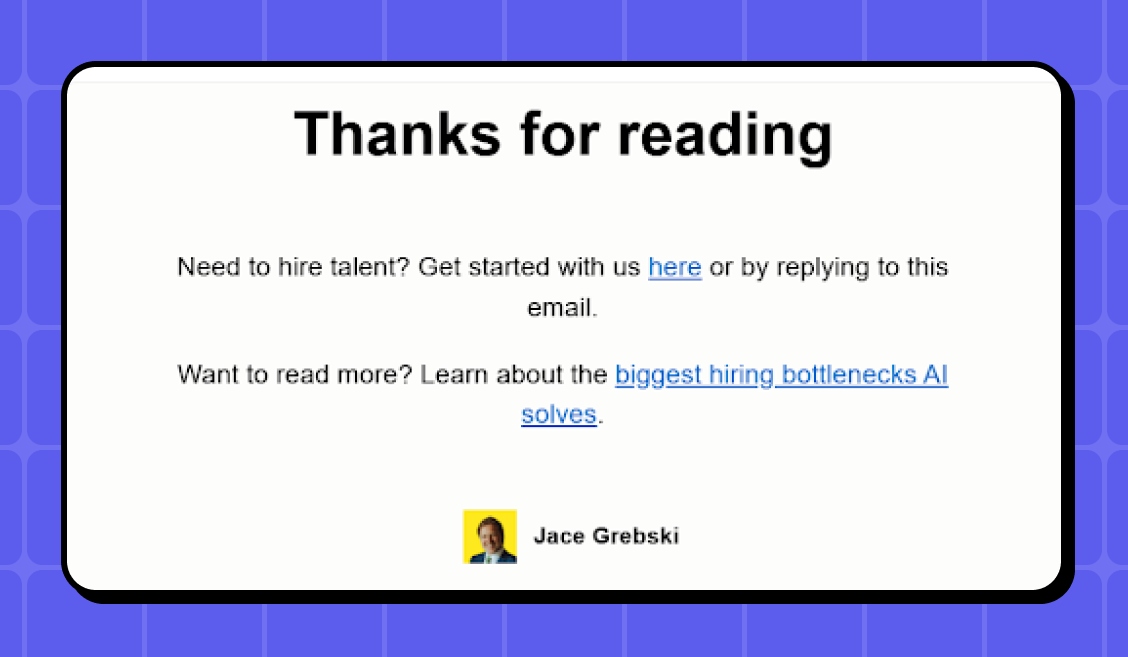
When you first launch your newsletter, limit your CTAs and focus more on engagement and building relationships. Once you're sending consistently, you can start sprinkling in CTAs.
A lot of people don't know this, but linking out to domains with low domain reputation can hurt your deliverability, so if your website is new, that's another reason to limit your CTAs in the beginning.
A lot of consultants plug a "book a meeting" type CTA at the end of their newsletters. Pretty forgettable, right? This easy-to-ignore status quo is actually an opportunity for you to stand out by dressing up your CTA to be perceived as high-value and low-risk as possible.
A much better CTA would be something like (if you were a marketing consultant): "Get a free audit to find 7 ways to unlock instant revenue from your existing traffic — without spending more on ads."
I like to dress up boring CTAs following one of these frameworks from Sabry Subi:
- X ways to achieve [desirable thing] without doing [undesirable thing]
- Do [difficult thing] in [specific time period] even if [shortcomings]
- Achieve [desirable thing] like [an expert] even without [something expected]
- How to eliminate [problem] without doing [the thing they hate] within [specific time period]
These are actually headline frameworks, but I like to repurpose them for CTAs.
Step 9: Stay Consistent & Optimize Over Time
The #1 way newsletters fail? Giving up after a few sends, after not getting the desired results.
Direct conversions – like booking a meeting with a lead – will come if you follow each step in this guide. But you need to consistently monitor your KPIs, test new ideas, and know what you need to improve based on each KPI.
Note: Before you analyze the metrics that could directly impact your pipeline, make sure you're not shooting yourself in the foot with poor deliverability. Your deliverability rate should stay around 99% or better. If your bounce rate rises above 2%, it could be a sign that you're emailing undeliverable addresses or your content is triggering spam filters.
Top newsletter KPIs you need to track:
| KPI | Meaning & How to Improve |
|---|---|
| Email List Size | The number of leads you have in your newsletter funnel. • Add new and old leads from your CRM • Add newsletter CTAs to your website, social posts, blog, and other content • Run paid ads |
| Spam Complaints | You're emailing people you shouldn't, or they hate your content 😬. • Remove inactive contacts • Verify that the contacts you add want emails from you |
| Unsubscribes | Leads aren't interested in your newsletter. • Reevaluate the value and subject of your content • A healthy unsubscribe rate (after you've been sending for 3+ months and pruning your list) is around 0.1%. |
| Open Rate (Industry and list-size-dependent. For consultants, aim for 30–40%) | Leads are interested in your subject line or newsletter. • Make sure your emails land in the main inbox • Tweak your subject lines to focus on what your audience wants • If this is < 14%, you're in spam |
| Link Clicks | Leads are engaged with the content inside. • Add more links to related resources • Make links more prominent with size, color, anchor text, or buttons • Make CTAs more compelling Caveat: The best newsletters don't rely solely on linking out to content; they focus on getting people to read the newsletter itself. Too many outbound links make for noisy CTR. Email clients cache emails, and many people check email with limited connectivity, so your email needs to be self-sufficient. |
| Replies | Your newsletter is good (or bad) enough for leads to take the time to comment. • Ask your audience more questions (especially in the intro) • Add CTAs that require a reply |
| Meetings Booked | Your CTA and offer resonate with your leads' pain. • Don't try to track attribution directly, most leads will read your newsletter, then visit your site directly or Google you • Ask leads how they found you and if they read your newsletter • Test different offers and placements • Revamp your CTA copy • Make your offer more valuable |
Attributing meetings booked can be a bit tricky, but there are a few ways you can measure impact:
- Add UTM codes to your links and CTAs to track via Google Analytics or your CRM (ex: ?utm_source=newsletter)
- Ask new prospects why they booked (and how they found you) on the discovery call
Then, you'll want to make sure your newsletter-influenced leads are tracked in your CRM's sales pipeline.
Step 10: Turn Engagement Into Consulting Clients
Look for subscribers who consistently interact with your newsletter. These readers are most likely to reply to an outreach message.
When you spot one of these subscribers, send a short message that's relevant to how they're engaging:
| Engagement Type | Outreach Message Example |
|---|---|
| Frequently Opens | Hey [Name], noticed you've been following the newsletter lately. Anything specific you're working on that I can help with? |
| Link Clicks (Be aware: Spam detectors and bot clicks can make this metric noisy. Potions filters this for you) | Hey [Name], did you hear about [news story topic of the link they clicked on]? Curious to hear how you're adapting. |
| Replies | Sounds like this is something you're thinking about internally. Want to hop on a quick call to dig into it? |
These messages work because they feel natural and not salesy, just a genuine check-in.
By the way, if you're worried about sounding creepy about knowing how often they engage with your newsletter, you don't actually need to call that out.
With our Potions customers, we turn this into an ongoing workflow. Every month, we generate reports of the most-engaged leads enriched with roles, company intel, and more.
This gives whoever's running sales a shortlist of leads to prioritize.
Remember, the goal is to stay visible until the timing lines up. When it does, you'll genuinely be providing value to a lead who likely needs your help – not spamming them – so don't be shy.
Let Potions Handle Your Consulting Newsletter For You
Most consultants want to stay visible, but time is their enemy. Between client calls, deliverables, and everything else on your plate, marketing your own business always gets pushed "later."
That's why we built Potions.
Potions is made for consultants who know the value of staying in touch but don't have the time to write, curate content, and manage a weekly newsletter. We plan, write, design, and send your newsletter so you can stay focused on client work and know it's going out right on schedule.
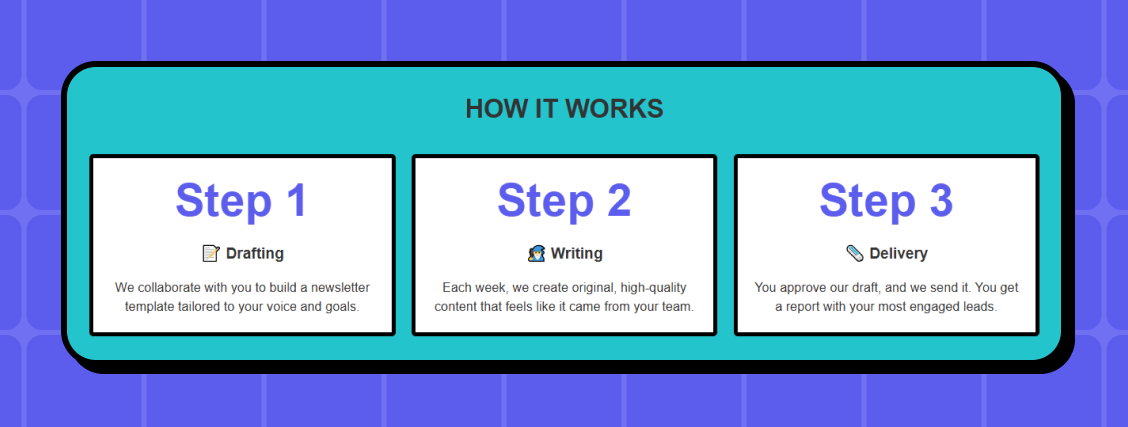
You share your insights and ideas, and we do the rest. Every issue sounds like you, looks professional, and lands in the main inbox.
AND you get all of this at one-tenth the cost of hiring an agency to run a similar service for you.
Ready to launch your consulting newsletter without burning out? See how your consulting newsletter could look → Get My Free Sample.
